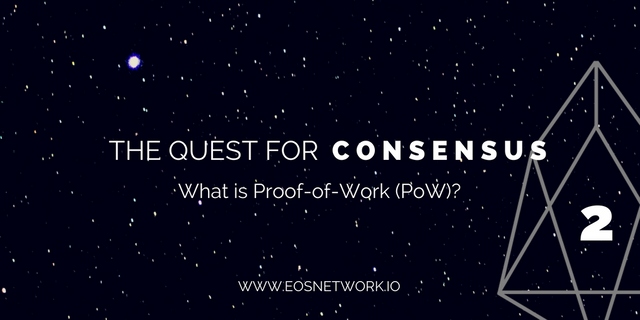The Quest for Consensus #2: Proof-of-Work (PoW)
.png)
What is Proof of Work? (PoW)
As we learned in the first article (available below), blockchain networks use various methods to reach consensus. The most popular of these is known as Proof of Work (PoW).
First article: https://steemit.com/eos/@ad-blockchain-ag/the-quest-for-consensus
Considered by some to be the crowning achievement of Bitcoin founder Satoshi Nakamoto, the idea was actually first published back in 1993 by Cynthia Dwork and Moni Naor. It’s gone on to lay the foundations for several blockchain-based networks and is the consensus mechanism of choice for the majority of cryptocurrencies currently in circulation.
In short, the purpose of this consensus mechanism and others like it, is bring us to agreement - to get us to trust one another - so that we don’t have to do.

How does Poof-of-Work ... work?
The idea behind PoW is relatively simple. To finish a page of the blockchain ledger, a block so to speak, nodes (users) must figure out a complex mathematical equation before they can validate transactions. This process is called mining, and those who take part in it are known as miners.
These mathematical problems are hard to compute but easy to verify. Once miners solve them, they are rewarded with the corresponding digital currency, referred to as a block reward. If the miners are mining on the Bitcoin blockchain, they’re rewarded in Bitcoin, if they’re mining on the Monero blockchain they’re paid in Monero, if they’re mining on the SlothCoin blockchain … you get the point.

The transactions in the block are then validated and the block is added to the chain. Real computational work goes behind all this, hence the term, Proof-of-Work. As time goes by the mathematical equations become harder and harder. This increase in difficulty, known as block difficulty, is intentional. The idea is to ensure that each mined coin requires an a similar amount of real work expended in the computational process — something that consumes a a huge amount of electricity.

Bittersweet Symphony
PoW is expensive. The Bitcoin network, according to a recent study published in Joule, claimed that the network currently uses about 24 TWh of energy per year— about as much as Ireland does.
As the Bitcoin network grows, it will require even greater computing power. The neatly designed Bitcoin Energy Consumption Index provides the latest fact and figures. And as you can see the charts are only going up. The energy usage is doubling every six months. It is estimated that by the end of 2018 it will consume 0.3% of the world’s electricity for the simple purpose of verifying transactions, albeit in a decentralized manner. Since these rising energy costs are paid in fiat currency, it builds a downward pressure that results in most miners selling the coins as soon as they are mined.

While PoW is expensive for miners, it does make for a structure that is relatively safe from attacks. That’s because the only way for an entity to disrupt the system and take command over the network is by controlling 51% of the hashing power. This is typically neither financially rewarding, nor a guarantee that the mounted attack will alter the transactions.
Ultimately, a Proof of Work system ensures that a blockchain is valid. For Bitcoin, it also means that the coins are not mined too quickly and miners have incentives to maintain the network. On the flipside, this also means that PoW is not an infinitely scalable protocol, as resources like hardware and electricity costs are finite.
Another big drawback is the formation of mining pools (groups of miners who pool their resources together) who could potentially control the network, adding a very real danger of centralization to what was created as a decentralized solution.

The devastating effect mining is having on the environment combined with the how financially unsustainable it is, and the threat of centralization, have led to the development of new ways of reaching consensus on blockchain systems - such as the Proof-of-Stake (PoS) system.
More on that in the next article.

This article forms part of a series aimed at educating people on the evolution of consensus mechanisms, the origins of DPOS and the EOS Block Producer race, and Advanced Blockchain's plans and proposal as a Block Producer candidate.
You can stay up to date with future posts through our social media channels:
Website: https://eosnetwork.io/
Twitter: https://twitter.com/EOSnetwork_io
Steemit: https://steemit.com/@ad-blockchain-ag
Facebook: https://www.facebook.com/eosnetwork.io/
Linkedin: https://www.linkedin.com/company/eosnetwork-io/
Reddit: https://www.reddit.com/user/EOSnetwork
Genial. Muy buena
Gracias Maria